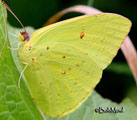Native Plants
Search for native plants by scientific name, common name or family. If you are not sure what you are looking for, try the Combination Search or our Recommended Species lists.
Senna hebecarpa
Senna hebecarpa (Fernald) Irwin & Barneby
American Senna, Wild Senna
Fabaceae (Pea Family)
Synonym(s): Cassia hebecarpa, Cassia hebecarpa var. longipila, Senna hebecarpa var. longipila
USDA Symbol: SEHE3
USDA Native Status: L48 (N), CAN (N)
Clusters of light yellow to orange flowers atop a sparsely branched perennial or in axils of compound leaves.
The flowers of this large plant are not typically pea-like. Two other species, Sicklepod (S. obtusifolia) and Coffee Senna (S. occidentalis), are also found in the East. Southern Wild Senna (S. marilandica) is a more southern species with fewer flowers and bigger leaflets.
Bloom Information
Bloom Color: YellowBloom Time: Jul , Aug
Distribution
USA: CT , DC , DE , GA , IL , IN , KY , MA , MD , ME , MI , NC , NH , NJ , NY , OH , PA , RI , SC , TN , VA , VT , WI , WVCanada: ON
Native Distribution: Ontario; Maine south to Georgia and northwest to Tennessee and Wisconsin.
Native Habitat: Moist open woods and disturbed areas.
Growing Conditions
Water Use: MediumLight Requirement: Sun , Part Shade
Soil Moisture: Moist
Soil pH: Circumneutral (pH 6.8-7.2)
Soil Description: Moist to average soil, sand to heavier loam.
Conditions Comments: Easy to care for.
Benefit
Warning: Plants of this genus (and herbal remedies derived from them) can cause poisoning and fatal illness in humans. Sensitivity to a toxin varies with a personís age, weight, physical condition, and individual susceptibility. Children are most vulnerable becausConspicuous Flowers: yes
Attracts: Butterflies , Hummingbirds
Larval Host: Cloudless sulphurs
Value to Beneficial Insects
Special Value to Bumble BeesThis information was provided by the Pollinator Program at The Xerces Society for Invertebrate Conservation.
Butterflies and Moths of North America (BAMONA)
|
Cloudless Sulphur (Phoebis sennae)  Larval Host |
Propagation
Propagation Material: Clump Division , SeedsDescription: Easy to start from seed or divide plant in early spring or fall.
Seed Collection: Seed matures in early fall.
National Wetland Indicator Status
| Region: | AGCP | AK | AW | CB | EMP | GP | HI | MW | NCNE | WMVE |
| Status: | FAC | FAC | FACW | FACW |
From the National Organizations Directory
According to the species list provided by Affiliate Organizations, this plant is on display at the following locations:Mt. Cuba Center - Hockessin, DE
Bibliography
Bibref 928 - 100 easy-to-grow native plants for Canadian gardens (2005) Johnson, L.; A. LeyerleBibref 1186 - Field Guide to Moths of Eastern North America (2005) Covell, C.V., Jr.
Bibref 1185 - Field Guide to Western Butterflies (Peterson Field Guides) (1999) Opler, P.A. and A.B. Wright
Bibref 1294 - The Midwestern Native Garden: Native Alternatives to Nonnative Flowers and Plants An Illustrated Guide (2011) Adelman, Charlotte and Schwartz, Bernard L.
Search More Titles in Bibliography
Additional resources
USDA: Find Senna hebecarpa in USDA PlantsFNA: Find Senna hebecarpa in the Flora of North America (if available)
Google: Search Google for Senna hebecarpa
Metadata
Record Modified: 2012-12-07Research By: TWC Staff